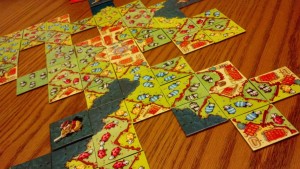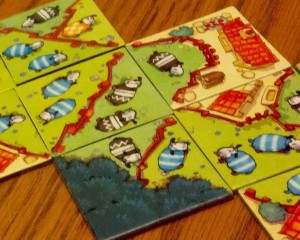Posted by barb on Nov 3, 2017 in
Entertainment,
Games 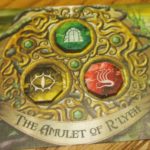
We just bought the Omens of the Deep expansion for Elder Sign, so I thought I’d try that for my Elder Sign solo play through. Omens of the Deep is another story-driven expansion with new adventure cards, new entrance, and the addition of missions (which are tossed in with the original monsters) and Deep Ones Legion monsters which are spawned separately from the regular monsters.
In this expansion, the investigators are on a ship, trying to prevent the awakening of the ancient one. The expansion has some cool stickers to keep and collect and more importantly new adventure cards. As with other recent expansions the game is played in two phases; in the first phase, the investigators are seeking out the pieces of a broken amulet and advancing an omen token. In the second phase, the investigators concentrate on getting elder signs and preventing the ancient one from awakening.
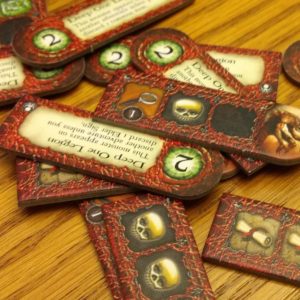
In the solo game, it’s not clear if I should just play one investigator or more, so I played a couple of different ways – once with two investigators, once with three, and once with four. I played that if I lost an investigator, I added a doom token to the doom track and did not replace the investigator.
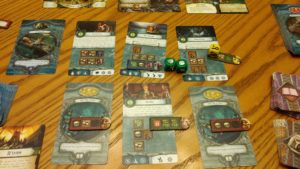
This expansion is HARD. I played three times, losing each time with only a handful of elder signs. I think I needed to concentrate on moving to phase 2 faster, but it’s not easy when you are just trying to keep your investigators alive. It feels like there are a lot more “sanity” penalties in this one than “stamina”, making high sanity characters much more desirable.
In the solo play-through, I miss the player interaction, and it feels like an awful lot of set up just for one person to play. However, I enjoyed it enough to play through three times, so I guess I couldn’t have been overly annoyed.
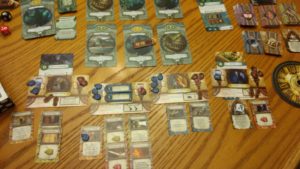
Tags: boardgames
Posted by barb on Sep 6, 2017 in
Entertainment,
Games 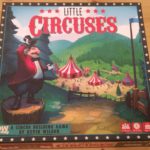
While I didn’t get to all of our games with solo variants while my husband was away, I decided to finish after he got back. For this post, I pulled out a new acquisition, Little Circuses.
In this game, each player builds their own circus with attractions in an attempt to entertain crowds and collect sets of different-colored attractions. you do this by buying attraction tiles such as a strong man, balloon vendor, elephant or giraffe, and contortionist. Then you move your spotlight around, guiding the visitors to the attractions you want them to see.
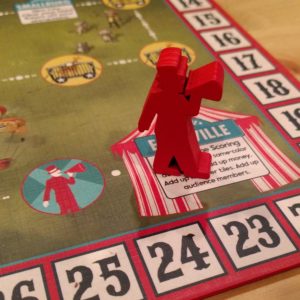
A huge note – the first edition of this game has a lot of mistakes. In the rulebook, the “clown” and “elephant” icons are mixed up, so I played this game a couple times thinking it was much harder than it needed to be. Those icons are also wrong on some of the star attraction cards. The rulebook has no explanation of the tiles with two colors, and my bleacher cards are all the same color, even though the rules refer to bleacher cards matching the color of the player score markers.
The solo-play variant isn’t much different from the multi-player game except you can only use the blue side of the star attraction cards, not the red side. This makes sense because the red side has a bit more player interaction.
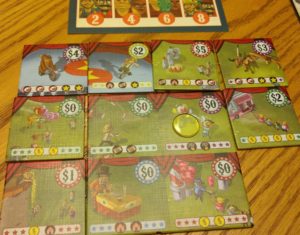
In the solo play game, you are trying to get the highest score you can, and will get a ranking according to the score chart in the rule book.
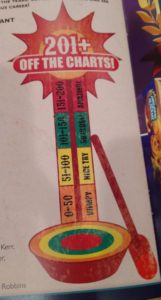
I played five times in the last couple of days, including two games before I found the errata online. Every time I was in the “Nice Try” range. I’m just not sure how to get a higher score!
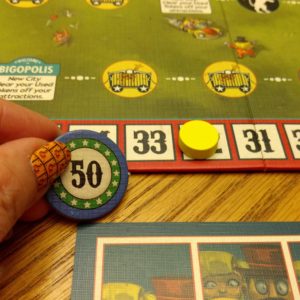
All in all, though, I found the solo play game to be fun. It’s a puzzle to try and figure out which tiles are the most valuable. Do you go for sets of colors? Or the ones with the powers you want to use most? Some combination of both? I’d definitely pull this one out again.
Posted by barb on Jul 7, 2017 in
Entertainment,
Games 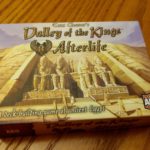
Up next on the solo-play list was Valley of the Kings: Afterlife. Valley of the Kings is a Egypt-themed deck-building game where you build-up your deck with purchases from a pyramid and then must destroy your deck strategically by entombing cards. Only cards in your tomb earn victory points.
There are three types of cards: starter cards, set cards, and unique cards. The starters are cards with low purchasing power but with actions that help you build up your deck with better cards. The set cards are cards have different themes, such as mummification, jewelry, and tomb art. Your score for each set is equal to the square of the number of unique cards in that set – duplicate cards are worth nothing. Unique cards are just that, one-of-a-kind cards available in the stock, each of which with it’s own victory point value.
In the solo variant, you play essentially as usual, but are attempting to entomb exactly a complete set of everything – your 10 starter cards, one of each of the set cards, and each of the unique cards. Any duplicates in your tomb count against you.
I came very close to winning, but I had one duplicate card in my tomb. It was my own fault. I made a conscious decision to have a duplicate because I thought I had a card that would let me essentially trade that for another card. Well, yes, I had such a card, but the duplicate that I put in my tomb didn’t meet the other conditions of the card that would let me trade it, so I was stuck with the duplicate entombed card.
It was a fun game; almost too easy. There is a harder variant, which I’ll likely try once I win the easy version once!
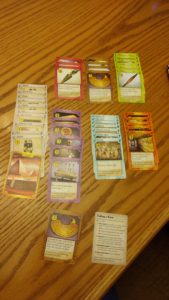
Posted by barb on Jun 29, 2017 in
Entertainment,
Games 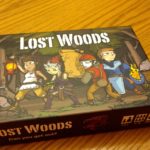
Next on my solo-play adventure was Lost Woods. Lost Woods is a map exploration game where adventurers collect gold and unique weapons all while defeating monsters and trying to avoid gold-stealing gnomes.
In the traditional multi-player game, each player is trying to escape the woods with the most gold. There is a cooperative variant which has players working together to ensure all 6 adventurers escape the woods with a minimum amount of gold. The co-op game adds the element of food, which counts down each round – run out of food, and you lose the game. The gnomes steal food instead of gold, and adventurers who lose fights against monsters must wait to be revived by a fellow adventurer, rather than simply losing a weapon and returning to the campsite.
For the solo-play variant, it’s played as the cooperative game, with the player controlling all of the adventurers. The adventurers must find one of the woods exits, battle the exit’s guardian, and then they all must exit with a minimum amount of collective gold before food runs out.
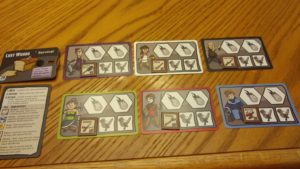
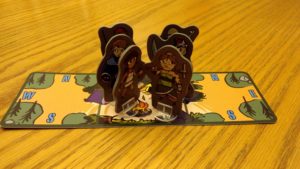
It’s a fun single-player game. The added element of the food, and the danger of losing a fight (especially before you’ve uncovered the “revive” spell) makes it a challenge.
I ended up losing, but just barely. Most of my adventurers needed just one more round to get out of the exit, but there was one pair who would have needed an additional round to get out. I should have kept them all together better, I suppose.
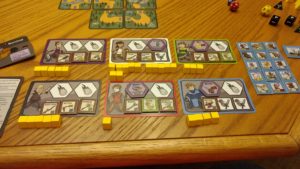
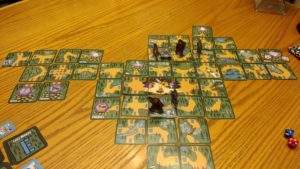
Posted by barb on Jun 20, 2017 in
Entertainment,
Games 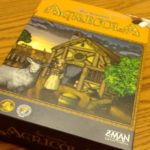
My next solo game was Agricola. In Agricola, you play a farming family starting with a couple in a wooden shack on a blank plot of land. The goal is to feed your family while you upgrade your shack to a clay hut and ultimately stone house, fill your land with crops and pastures, acquire farm animals, install major and minor improvements to your house, and employ people to help out.
If you’re not familiar with the game check out a play-through.
In the solo play variant, the game is set up like a two-player game (so, there are no extra worker spaces on the board) and you start the game with no food. Otherwise, game play is the same as the multi-player game, with you just taking one turn after another.
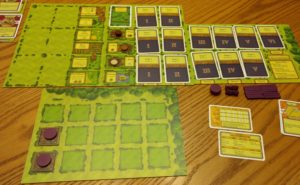
As always, when I play Agricola, I feel like I just can’t make any headway. While in the end I had a full farm board, I had used all of my fences, and I have some leftover grain and vegetables, it was a struggle the whole way.
I’m not shy about playing hard games, but for some reason Agricola has just not resonated with me – I never feel like I’ve played a good game, even when I win the multi-player version.
I suppose this time was certainly easier, since I wasn’t fighting other people for prime positions, and I could plan a few moves ahead without suddenly compensating for losing the spaces I wanted. Playing solo also meant that the resources piled up until I grabbed them, meaning that I could get lots of anything at once, if I waited long enough. But even though that challenge was removed from the game, it was still challenging to build up my farm, make a family, get livestock, feed everyone, and renovate my wooden shack.
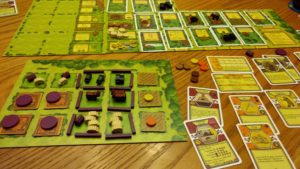
I ended with a score of 35 – 15 less than the goal of 50 points. I would have had 41 if I hadn’t had to take the two begging cards, but still short of the goal.
Posted by barb on Jun 13, 2017 in
Entertainment,
Games 
Next up was Suburbia. This is a tile-laying game where you try to build up your town into a thriving city. As you purchase civic buildings, housing, businesses, and industrial buildings, you adjust your city’s income and reputation to earn cash and population. The goal is to have the highest population at the end of the game.
Each tile you lay has the potential to help or hurt your income and reputation. It can also bring in cash directly. In the multi-player game, your tiles can also affect the income and reputation in other players’ cities. Finally, there are universal and individual goals in play to help players choose a direction for their cities (and make extra points!).
There are two versions of solo-play, I only played the first. In this variant, the game is set up as it is for two players, but no goal tiles are dealt out.
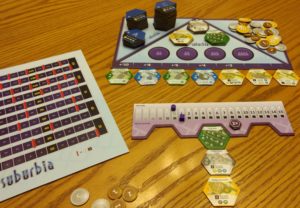
Differences from a typical game include the following:
- No goal tiles in play
- After each turn, a tile is discarded from the market – it’s the player’s choice, but if you pick anything other than the first two, you need to pay the cost of the market position
- When the “one more round” token is drawn from the “C” stack of tiles, the game ends immediately
- When your population crosses a red line on the score board, your income and reputation are each reduced by two, rather than one
Here’s my final city:
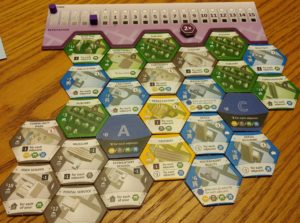
And my final score:
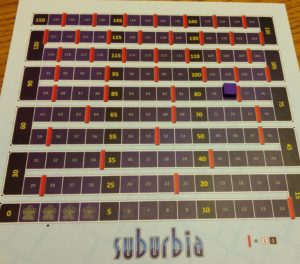

I’ll confess, I have this game on my tablet, so I’ve played some version of the solo game previously. However, the tablet also has a number of challenge modes – building a city with low reputation but high income, filling in a city from some pre-laid tiles, etc.
The game involves a lot of set-up, which the tablet eliminates, but I miss the tactile element of the physical game. I found I enjoyed this more than I thought I would.
Early in the game, the additional penalty for growing the population didn’t seem too bad. I was able to keep my income high and reputation modest, even with the penalty. Then, at some point, I couldn’t continue to overcome it, and ended up with several turns where I had negative income, reputation, or both.
It was a fast game, and I found myself eyeing the 60-population spot on the board, knowing that was the minimum I needed to not be in the lowest ranking. And while I enjoyed the game, I did miss the player interaction that comes from the multi-player game – thinking twice about buying another airport or housing development because I didn’t want to help other players with their income or cash-flow.
Posted by barb on Jun 6, 2017 in
Entertainment,
Games 
Next on the list for testing out the solo-play variant was Wizards of the Wild. In this game, players are animal wizards who battle in a magic contest run by acolytes of the Lost Masters. Dice rolls determine what resources you have each turn, along with saved resources on your card. Collecting a carefully curated set of spells, you can set up combinations to supercharge each turn.
In the solo play variant, you play against a dummy opponent who starts with the standard starting set of resources and a number of points based your chosen difficulty. The opponent can lose resources and points, based on the spells you use and the “skull penalty” for each round. And you, of course, try to make as many points as you can in the usual fashion – through victory points earned on your turn using spells or overcoming challenges, bribing the acolyte, and end-game victory points on spells and challenges.
I’ve actually played the solo variant of Wizards of the Wild a few times before – I pulled it out when I first got the game so I could learn the mechanics and understand the types of cards.
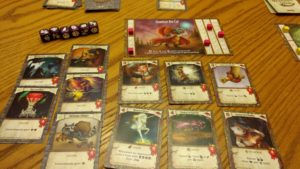
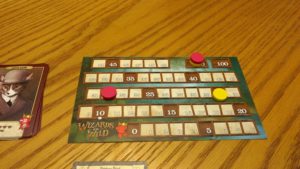
As with the multi-player version, the solo variant is quick and easy to play, and has great art to look at. The key is to find spells and challenges that work together to maximize the combinations you can make each turn – this seems even more true in the solo game. I’m not sure how often I’ll pull it out for solo play, but it was enjoyable.
I played twice, and finally won the second time. I think that’s the only time I’ve won the solo variant.
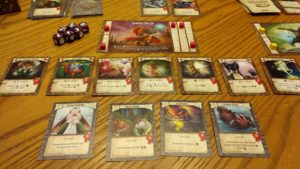
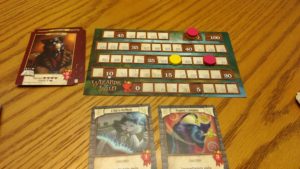
Posted by barb on May 30, 2017 in
Entertainment,
Games 
While I was home alone for a week, I decided to try out some of our games that have solo-play variants. First on the list was Mint Works. This is a worker placement game that fits in a mint tin. Each player is building a neighborhood in the city of Mintopia.
I’ll confess, I’ve only played this a couple of times before trying the solo variant. As a multi-player game, it’s a fun, fast-paced worker placement game. There’s more depth to the game than you might expect from something that fits in a mint tin. The “workers” are your mints, which double as currency, forcing you to balance how much you spend each round with how much you want to save to purchase better buildings for your neighborhood. You can check out a run through (from Rahdo), if you want to see more about the game play.
For the solo-play variant, you employ one of four AI opponents. They each have different special abilities, game mechanics, and card-buying preferences. The location cards (the cards with worker spaces) are places in a line with a specific order. The AI will always take the first available open worker spot, from the top down, that they are able to legally play. They would play until all of their mints were gone or until there were no more legal spots for them to go.
I played three games, the first two with one AI and the third with a different one. In the first two games, I added one of the optional advanced locations to game, and in the third I played with just the basic locations.
The first AI I played with, Sonic, always took 2 turns in a row, which meant he always had a ton of mints (the first location is a place to spend one mint to get two – he would always get to use that space twice).
In the first game I had the Recycler as the advanced location – if you use this location, you discard one of your plans or buildings in exchange for mints equal to the cost and “star” value (stars are essentially victory points). By following the rule that he plays until he doesn’t have a legal spot to play, he always played this location and lost whatever plans for buildings he had in his neighborhood. I won handily, despite his loads of cash.
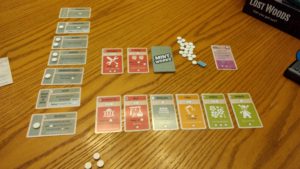
In the second game, I swapped out the Recycler for the Crowdsourcing location, which just got Sonic more cash. Since he wasn’t having to trash his plans and buildings, he won quickly. With all his mints, he could always buy the expensive plans, which are worth more stars.
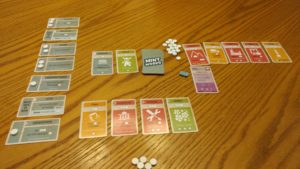
In my third and final game of the evening, I swapped out Sonic for AI Justin. Justin blocks all other spaces on a location when he plays there and he starts with the start player marker. This meant I was always had an uphill battle to get mints – he blocked the Producer right away, which is the location where you exchange one mint for two. Justin he would go after the cheap plans, so we were fighting for the same plans. Then he built the Assembler, which allows a player to automatically build plans without having to visit the builder, at which point I was completely screwed.
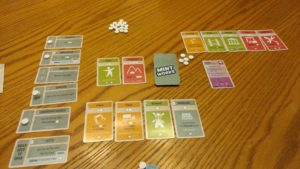
Overall, I found the AI mechanic interesting. Since I always knew what they were going to do next, I could plan my moves to ensure I could block them when I needed to. However, since the order of the upcoming building plans was unknown, there was still an element of surprise and continued need to change strategy.
The mechanic was clearly broken for the Sonic/Recycler combination, and I would not recommend playing those together, unless you wanted a quick win. For the other two games, it felt almost impossible to win. I’ll have to play some more to see if that feeling is true. I understand that a solo game should be challenging, since winning every game gets boring. However, it still needs to feel winnable.
I’ll certainly pull this out again when I find myself alone and wanting to play a game.
Posted by barb on Sep 9, 2015 in
Games I rediscovered Kickstarter when the Veronica Mars folks were trying to fund their movie. I now peruse the games section regularly and put some money behind a new game every once in a while. In the past year, I’ve received four games that I’ve backed – Evolution, [redacted], Exploding Kittens, and Galaxy of Trian. I’m happy to say that three of them turned out to be pretty fun. Here is a quick review of each of them.
Evolution
Evolution came about a year ago, and we’ve played it at our game nights a couple times. The game mechanics are fairly simple, and easy to remember once you play through a couple of rounds. In each round, you draw cards, then play one to the watering hole — these will be revealed later, but determine how much food is available to the herbivores. Then everyone plays at once (they recommend this for the 6-player game, but it speeds things up, so we do it for all games), playing as many cards as they want to do a variety of tasks: add a new species, add a trait to a species, grow the population a species, grow the size of a species. Then the food is revealed, and the players feed their species, going around the table starting with the start player. Herbivores eat from the watering hole, and carnivores attack other species as they can. The food is swept into a bag, and then the next round starts.
I liked this one enough to support the expansion Kickstarter this past spring – Evolution Flight. We haven’t played with the expansion, but will likely do that at our next game night this month.
Exploding Kittens
Exploding Kittens is a simple card game which caught my attention because one of the co-creators is the guy behind The Oatmeal. It’s easy to learn and quick to play. The art is a lot of fun (as expected).
Game play is simple, play some cards, then draw a card and hope it isn’t an exploding kitten. If it is an exploding kitten, hopefully you have way to defuse it, otherwise you are out of the game. The last unexploded player wins.
Since it’s fairly quick and easy to explain to newcomers, this is a great game to play on game night while waiting for another table to finish their game.
[redacted]
[redacted] came on Kickstarter shortly after Evolution, and it looked like fun, so I backed it. I received the game late last year (December, maybe?). After reading the rulebook, I had no clue how the game play worked – it felt like the rules needed another go-through by people unfamiliar with the game and maybe some reorganization. So, the game sat on our shelves for a while.
One of my game night regulars kept asking when we would try it out, but I hesitated to play it at a normal game night, because it would take a lot of start-up to figure out the rules. We decided to try it out with just four of us last week at a small game night.
I re-read the rules ahead of time, as did my husband. The game play itself sounds relatively simple – each player is a spy working with another player, but they don’t know who their partner is until they discover each other through interrogations. Each player moves through an ambassador’s house with a specific objective in mind, depending on the scenario being played. In our game, we were two teams of trainee spies trying to activate a computer virus, requiring one of us to find the right floppy disk and discard it in the computer room while another player is in the control room. Players take turns moving through the board, stopping when they reach a room they want to use or when they encounter another agent.
Each room has a different function or ability – from the storage rooms where agents can pick up new items to the X-ray room where an agent can look at other players’ items as they pass through X-ray-enabled doors.
However, the mechanics of the player encounters was confusing, game start-up was not well explained in the rule book, and it wasn’t clear when items were to be discarded. We had to consult the rules during every player’s turn, and often couldn’t find what we were looking for.
Expect we could watch the hours of online videos about the game to figure out the answers to our questions, but the game should be completely contained in the box. I shouldn’t have to have an outside source available to determine the rules. I don’t expect to try it again.
Galaxy of Trian
Galaxy of Trian was another that came on Kickstarter shortly after Evolution, but the game itself took a bit longer than the creators projected, so I only just got it about a week ago. However, I appreciate that they took the time to get the game right – the components are well-made and the rules are clear and well-written.
The game itself is a bit reminiscent of Carcassonne in that you play tiles with the goals of closing nebulae, connecting planets, walling off empty space, and preventing your opponents from doing the same. You have the option of playing an emissary on a tile as it is played, and those emissaries can occupy a nebula (and extract minerals once its closed) or a system of planets. The trick is that you have to have the most emissaries in a region when it is closed to occupy it. And, if the non-controlling player closes a region, your emissaries are stuck there for the rest of the game…unless they are in a position where you can play a teleport or exmitter on an adjacent tile AND you haven’t upgraded them to aa research station yet.
Andrew and I played a couple times. It will be interesting to see how it plays with additional players. The Kickstarter version I bought also came with a number of expansions, however, I want to try the base game a few more times before introducing those.
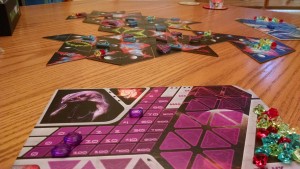
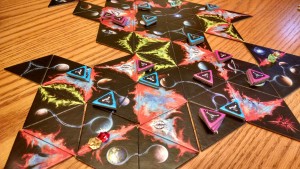
Posted by barb on Jan 29, 2014 in
Games
Several years ago we took a board game class through our county’s community education series. One of our favorite games (as evidenced by the fact that we bought it) was Wooly Bully. In this game, each player is a farmer with a different color (black, blue, red or yellow). Your goal is to fence in as many of your sheep as you can by the end of the game. This can be done in one large enclosure or in many small enclosures — whatever sheep you have completely enclosed scattered around the full playing area count toward your score.
At the beginning of the game, only you know what color sheep you have. You lay tiles, matching sheep colors and/or terrain (there are “village” sections and forest sections — see the detail picture showing a few tiles). When you lay a tile, you replace that tile but you also get to pick additional tiles if you match more than one side of the tile you laid — this way you can get more tiles in your had to choose from.
The village and forest tiles count as “fences” to completely fence in your sheep. However, you need to beware the forest — there are a four wolf tiles that can be played at any time. These wolves in the forest nullify any sheep enclosures that use that forest to close them. If you are lucky, you might have a hunter in your hand that can also be played at any time. The hunter kills the wolf, thereby making your sheep safe again.
To make the game a bit more complicated, each tile is double-sided, so you can play the reverse side of the wolf or hunter to get four additional sheep of a single color — this is a bonus if you happen to get the hunter or wolf with your color of sheep. But, of course, there’s some strategy to how and when you play that tile!
We’ve found that this game isn’t quite as fun with just two players, but works quite well for 3 or 4 players. The rules are very simple, so it’s also the perfect game when you don’t have a lot of time to explain the rules of a complicated game or you just want to get right into a game. The strategy shifts from game to game as you try to figure out whether to make a lot of small enclosures to to go for a ginormous, rambling pasture.



































